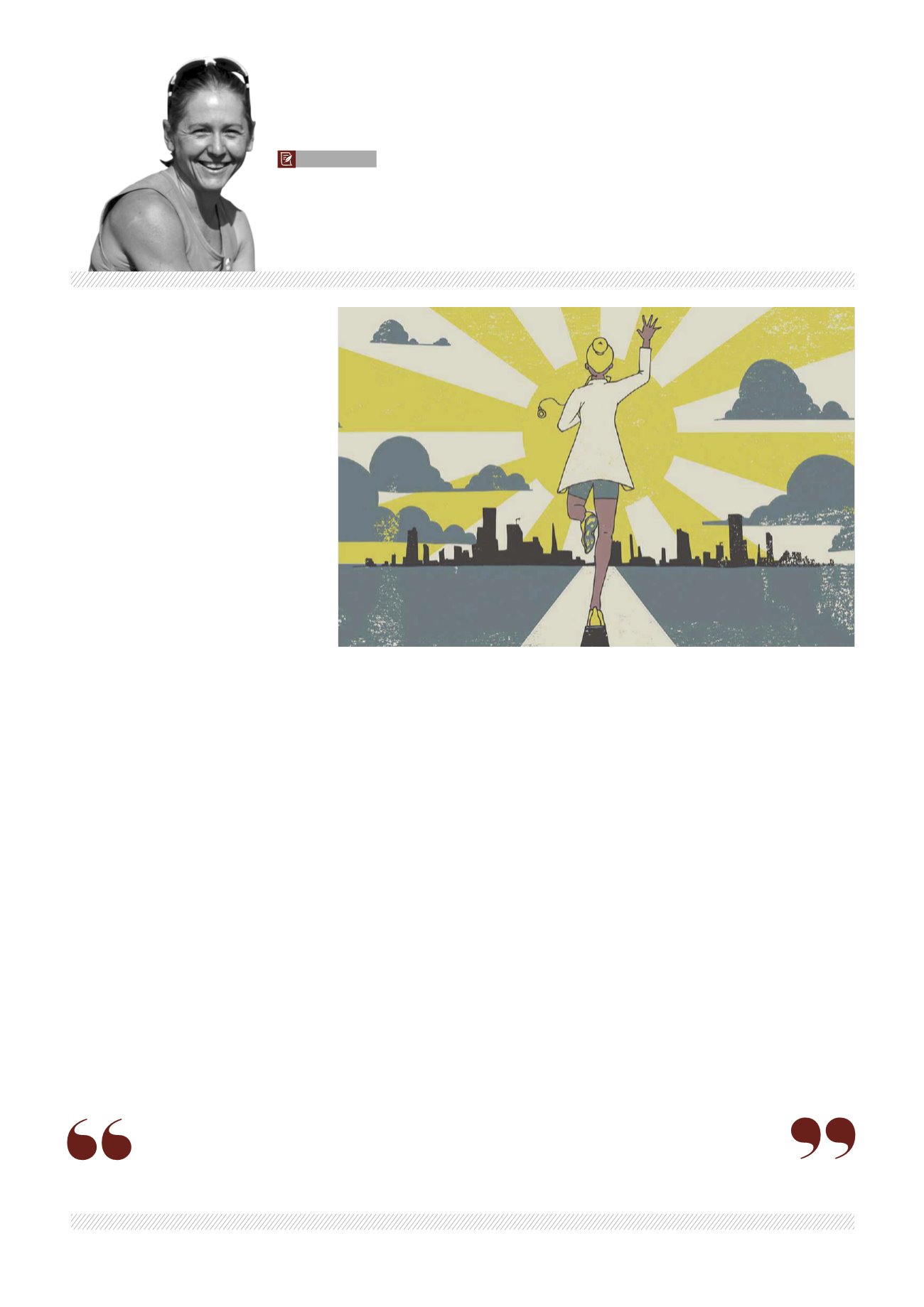

M
oral strength is about making a
conscious decision to be a person
who doesn’t give up when it would
be easy to…. None of us get out of life alive.
So be gallant, be great and be grateful for
the opportunities that you have.”
This was the quote with which I started my first
column just over a year ago. It came from Jake
Bailey, an 18-year-old head boy who had just been
diagnosed with an aggressive and life-threatening
cancer. He’d been allowed to leave hospital just
once during his treatment, to make an extremely
emotive speech at his final school assembly, and
this quote was his take home message.
One year on and Jake Bailey is in remission. In
a recent speech, when talking about the lessons
he’d learnt from his experience, his motto was
‘Embrace each day’. Simple words. Yet when
taken in context, these words have meaning, and
perhaps we can all learn from them. When I look
back on my battles over the last year, and my two
and a half years as a full-time athlete, I’m proud
of the way I dealt with obstacles. I made the most
of every single day and honestly don’t have a
single regret with how I managed this time.
I’m now back working three days a week as
an oncologist. People ask me if it’s depressing.
And surprisingly it’s not. Sad at times for sure.
But no matter how bad a day has been, every
day when I get home I know I’ve been useful.
And in many ways it’s a life-affirming specialty
to work in. Working as an oncologist makes you
appreciate the small things in life because every
day I’m reminded how short life can be. So
when I leave work in the evening to run home,
rather than bemoaning the fact that it’s dark
and cold and I’m tired, instead I appreciate how
lucky I am to be able to run home and embrace
the fresh air, endorphin rush and tired legs that
I get at the top of the hill.
Yes there are frustrations working for the NHS.
But for me it’s nice to be doing something useful
again and I’m enjoying using my brain. And
training wise, so far it’s working well. It’s incredible
how much less faffing I do on my three workdays
than on my four non-work days. Only having
90mins to get a 90min session done is a brilliant
motivator when it comes to getting started.
I’ve been using my commute to train – running
to and from work and cycling to and from a
different hospital when I have to do a clinic.
In her last column, Lucy assesses her new work/tri balance
ILLUSTRATION
DANIEL SEEX
Run commuting gives me a huge sense of
satisfaction in light of its time efficiency. In effect I
get a 90min session done in 45 minutes (take off
the standard commute time). There’s nothing
quite like fitting 18-19 hilly miles in around a day’s
work and having all your training done and dusted
by 7:30pm. And I’m not going to pretend I don’t
enjoy the kudos I get from people at work telling
me they saw me ‘galloping’ past the queues of
rush hour traffic on the ring road and beating
them in their cars! Last week, when clinic finished
early, I told the nurses, ‘Brilliant, I can cycle the
long way home.’ The look on their faces was
priceless as they told me to ‘Go and lie on the sofa
Lucy with a glass of wine.’ I think if they realised
that my version of the ‘long way home’ was 40
miles they would have had a heart attack.
I’m also learning what food I can and can’t
run with. It turns out most things turn to mush
with a run commute and you need tough
Tupperware to survive the onslaught of off-road
running with hills! One day I turned up with an
explosion of chicken and onion in my rucksack,
all over my work clothes. And running with a
stethoscope and ID badge in the same
compartment was a big mistake. Somehow they
ended up so entwined that I could only separate
them by cutting the ID badge lanyard!
Logistically, I’m remembering how important
planning is in order to train around work. Getting
the right bits of kit in the right places is a
nightmare and I’ve had to run in cycling tights and
go without underwear on at least one occasion.
But perhaps the biggest change for me on my
workdays is the time spent preparing and eating
food. As a pro, eating used to take up a large
proportion of my day. When I’m working I simply
don’t have that time. Finding healthy meals that
survive a run commute and give you good
calories in an easily consumed format is
challenging. But I’m getting there! Nut butters,
rice cakes and the new High5 protein balls are
saving the day in terms of healthy snacks to help
avoid the endless supply of chocolates and
biscuits that are lying around.
For me, the last month has been one big
learning curve. Learning how to be a doctor
again. Learning how to juggle triathlon with
something else again. Learning to have a bit more
balance in my life. But perhaps the biggest lesson
for me has been the daily reminder to make the
most of life. It’s short and we need to live it.
This is my last column for
220
. After more than
a year of my waffling, I hope I’ve been able to
provide an insight into the life of a pro. So thanks
for reading and I’ll see you at the races!
Q
220
114
I
WWW.220TRIATHLON.COMI
FEBRUARY 2017
EVENTZONE
COLUMNIST
Life of a Pro
LUCYGOSSAGE
There’s nothing quite like fitting 18-19 hillymiles in
around a day’swork and being done and dusted by 7:30pm

















